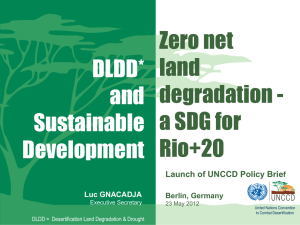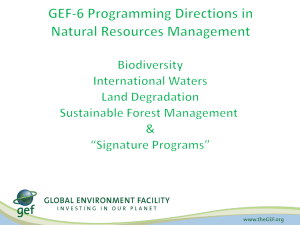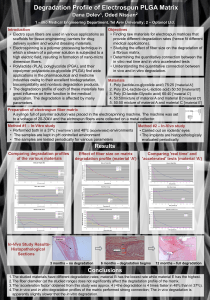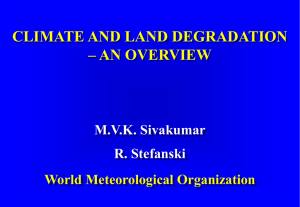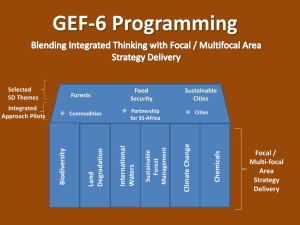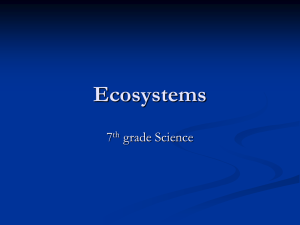Land degradation influences to climate change
advertisement
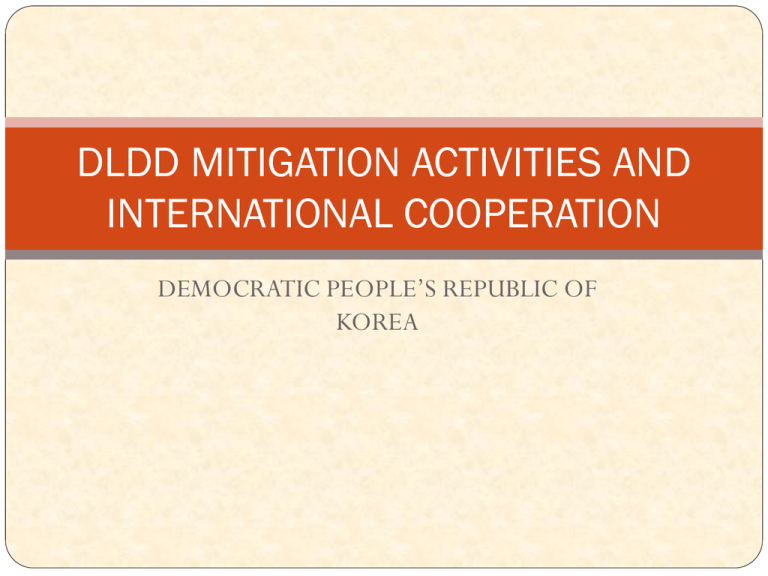
DLDD MITIGATION ACTIVITIES AND INTERNATIONAL COOPERATION DEMOCRATIC PEOPLE’S REPUBLIC OF KOREA INTRODUCTION The country is occupied with mountains and hills of nearly 80% Temperate climate, annual mean precipitation: 1000 mm or so prone to soil erosion in sloping lands Severe drought in Spring and heavy rain in July and August Land use Status Mountainous occupies 80% of its 2% 6% 2% 15% 2% 73% Forest Settlement Agriculture Industry Water body Other Deforestation and forest degradation 4 Land degradation in farmland - Soil erosion in sloping fields Much soil and nutriments are lost by run-off, wind, gravity. Soil loss Nutritive elements wash off Soil humus is very low. - Re-salinization of tidal paddy Rice yield is lower - Drought and Flood damages In spring season, severe drought damage. Many non-paddy fields suffer much more damage by flood after severe drought. In rainy season, severe flood damages. . Correlation between Land degradation and Climate change - Climate change accelerates land degradation Air temperature is 1.9℃ increased by warming Extreme weather (heavy rain, drought) Sea level rise, rising of ground water level Increased soil erosion and land slides Increased natural disasters (water shortage, floods, drought damage) Inundation of tideland Corruption of equilibrium of ecosystem; Change of tree cultivation with economic value boundary - Land degradation influences to climate change Land degradation – removing of vegetation – decline carbon stock – reduce carbon absorption capacity – accelerate global warming Contribution to climate change of land use: 25% Thus, Mitigation of Land degradation: win-win practice for climate change adaptation and mitigation IMPACTS OF DEFORESTATION AND DEGRADATION Reduction of soil productivity Reduction of forest resources Weakness of regeneration capability Decline water control capacity Increase soil erosion Floods Biodiversity loss due to fragmentation of ecosystem and destruction of habitats Shortage of Food, Fuel & Timber Decline of local economic & livelihood Increase of disasters, Reduction of productivity, Biodiversity loss Main causes of Land Degradation Cause-Status-Impacts Analysis Impact Food Security Influe nce Decreased natural resources Sustainability of natural resources Poverty Decreased land productivity Status Forest degradation -Decreased forest cover -Erosion & land slide -Decreased organic matter -Decreased regeneration capacity -Decreased water conservation capacity -Decreased biodiversity Agricultural land degradation -Loss of agricultural land -Erosion & decreased fertility -Acidification, resalinization -Decreased water conservation capacity & drought -Water logging, increased ground water level -Soil pollution Direct Deforestation & land use cause change -conversion to cultivation land -conversion to grazing land -conversion to construction land for infrastructure Unsustainable forest management -over logging(wood, fuel wood, NTFP, extraction of soil humus) -ecological unsound cutting method -pest damage Lack of institutional capacity Root cause Instituti policy/ onal Subsidiary Financial legislation arrange means sources ment Scientific resources Living Environment Decreased regenerative capacity Land of settlement -Soil erosion -Sand storm Loss of arable land -development of infrastructure -erosion, sedimentation -land falling in coal mining sites Natural Disasters Global Warming Biodiversity Fluctuation of water control function Decreased carbon pool Decreased social value Land for industrial use -Erosion from road side slope -Erosion from mining residue sites -Soil pollution Land covered with water body -siltation -pollution Other land -degradation of marginal land of protected areas Unsustainable manag ement agriculture -lack of soil conservation -mono culture & successive culture -chemical fertility & pesticide use -use of solid wastes -lack of water Water resources management -flood control -drought damage -pollution Lack of adaptation capacity in climate change -flood damage -drought damage -extreme weather Global environme Populati Lack of Shortage of nt change External Human Public on arable energy especially pressure resource awarenes growth land sources climate s s change Constraints - Continuous deforestation and forest degradation to solve food shortage and fuel wood - Soil erosion, decreased soil fertility, soil productivity - Weakness of resilience of land to climate change, flood, drought - Poor healthy of pure conifer stands, pest outbreak - Biodiversity loss due to land degradation - Unsound waste treatment in coal mining, mineral mining area factories, enterprises, and soil pollution - Water logging of land relation to infrastructure construction Policy related to land management National policy - Greening of whole country - Integrated use of mountains National planning National Land Construction Master Plan Forest Development Master Plan Rotational timber logging plan Annual aforestation/reforestation plan National and social activities General turn-out period for land management in spring and autumn Afforestation/reforestation by whole people Forest management through distributed management responsibilities among local communities and institutions Legislation related to land management Land Law, DPRK (29th April, 1977) Law on the Environment Protection, DPRK (9th April, 1986) Law on the Land Use Planning, DPRK (27th March, 2002) Forest Law, DPRK (11th December, 1992) Law on the Agriculture, DPRK (18th December, 1998) Law on the Water Resources, DPRK (18th June, 1997) Law on the Environment Impact Assessment, DPRK (9th November, 2005) Law on Rivers and Streams, DPRK (27th November, 2002) Law on Natural Protection Areas, DPRK (25th November, 2009) Government’s Efforts to Mitigate DLDD DPRK ratified UNCCD (2004) and prepared and validated the National Action Programme to Combat Desertification/Land Degradation (June 2006). Main Activities for implementation of NAP - Government policy: Mountain and water treatment, reforestation and greening of the whole country - Rehabilitation and improvement of more than damaged, capacity of seedling production –/year - General turn out months for land treatment, more than of reforestation/year, mitigated deforestation and forest degradation - Several tens km dykes built and repaired to prevent natural disasters and rehabilitate damaged areas - Agroforestry development and extension - Organic farming, conservation farming for enhancement of soil humus and fertility - Terracing with protection grass belt to control soil erosion in sloping land Constructed gravity-fed water canals for providing irrigation water to the agricultural land Included watershed management and agro-forestry in curriculum of Agricultural Universities and Colleges AF Policy of the Government △ Necessity ‐Natural and geographical characteristics o 80% mountainous, complex topography➡Limited arable land o Geographical location ➡high risk of natural disaster ‐Situation o Continuous economic sanctions by outside forces o Economic difficulties since mid 1990s o Consecutive natural disasters ‐For building a powerful socialist state o Food security, people’s livelihood, sustainable development of the economy o Disaster Risk Reduction, protection of ecological environment, landscape improvement △ National Policies ‐Make good use of the mountains in the mountainous regions and the sea in the coastal regions! ‐All-out mass movement for more arable lands! ‐Well-regulated discipline of land use for maximized effectiveness! ‐Development of fruit culture and sericulture, creation of more economic forests! ‐Comprehensive utilization of mountains, development of local economies! ‐Rural development, rural people’s livelihood improvement! ‐All mountains into gold and treasure mountain! ‐Afforestation and greening of the whole country! ‐Environmental protection, prevention of natural disasters such as flood! ‐Development of agriculture and light industry, food security and people’s livelihood improvement! △ Agroforestry as national policy ‐Main purpose o To solve food shortage problem and promote reforestation on immediate terms o To contribute to the conservation of eco-environment and the sustainable development of the economy on long terms ‐Measures o Provision of legal basis o Systematization, AF on a scientific basis o In a planned way on a long-term perspective o Raising public awareness, AF as an all-out mass campaign o Strengthening scientific research on AF development o Enhanced education for training AF experts △ State measures for AF extension ‐Demonstration show, introduction and propaganda by means of newspapers, radio and news ‐Provision of legal guarantee o Amendment and supplement of the Forest Law Article 19, Issuance of rules and regulations ‐Guidance system on the nationwide scale o From the national level to the provincial, city and county levels, establishment of non-standing consulting bodies and standing executive bodies ‐Thorough survey of AF plots and preparation of a far-reaching plan ‐AF extension as an all-out mass movement, nationwide movement o Various economic methods (guarantee of the right to use forest land and the right to the disposal of products) ‐Strengthening of scientific research and training of AF extension workers Overall Objective Through the extension of good AF experiences in model sites to the nationwide scale To solve urgent food problem and recover damaged forest ecosystem Furthermore, to achieve eco-environment conservation and sustainable development of the economy Purpose of applying AF To protect environment (conservation) To gain high yield (production) Sustainable development Road Map for the Preparation of the AF NAP Organization of the National Working Group Field survey throughout the whole country Identification of provincial priority projects Identification of strategic targets of the AF NAP and national priority Preparation of the AF National Strategy and Action Plan Preparation of the Financial Strategy for the implementation of the AF NAP Endorsement of the draft by the Government On-going … Development of AF National Strategy and Action Plan supported by SDC (2014) Food security and disaster prevention for sloping land user groups(SLUS) in 3 Counties of North Phyongan Province (EUPS 4, 2013-2014) Prepare … Natutal disaster prevention through introduction agroforestry and waterwhed management AR/CDM and preparation to attend in REDD+ Programme UNCCD NAP Alingment Challenges to DLDD Mitigation Lack of awareness/advocacy and institutional capacity for mitigation of land degradation and sustainable land management Lack of awareness about the significance of sustainable land management and land degradation mitigation Lack of improved regulation and guidelines related to land use Weakness of land use coordinating structure Lack of capacity for scientific research and technical services – absence of database regarding to land degradations – Lack of research on land degradation – Poor technical service skills for land degradation mitigation Lack of financial resources to input to land degradation mitigation activities Recently, climate variation is more severe for mitigating DLDD More risk of floods due to most of the country area (80%)- mountanous Increase the resilience of land to climate change, climate adaptation, needs enormous input Conclusion Deforestation and forest degradation, according to land degradation are most important environmental issue in DPR Korea 2. Policy willingness of the government and international cooperation create important opportunities for land degradation mitigation 3. Aligned NAP should include measures and approaches to successful mitigate land degradation through social participation, responding to climate change 4. To replicate and extend best practices and experiences and to build institutional capacity are priorities, which should be combined with food security and livelihood improvement 1. Thank you for attention!
